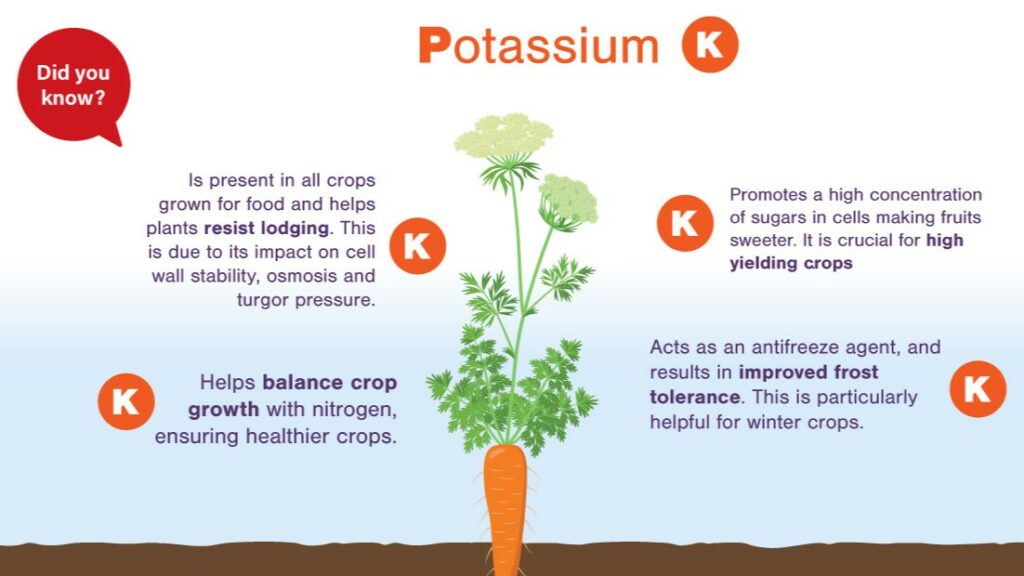Whether preemptively preparing your soil for new growing seasons or replenishing nutrients in your veggie garden, fertilizers are practical ways of enriching your soil. However, there are several fertilizer types, and knowing which one to use is often challenging. For example, when would you use a high-potassium fertilizer, and what are the benefits?
Potassium is a quintessential macronutrient for all plants. Potassium is significant in facilitating root, flower, and fruit development, promoting the transportation of nutrients and water. High potassium fertilizers are added to the soil when there is a deficiency, particularly in crops.
Without potassium, plants cannot grow and develop. But how exactly does this nutrient influence a plant? What are the best sources of potassium? When would you use a high-potassium fertilizer, and what are the drawbacks of using this intervention?
High Potassium Fertilizers Explained
If you’re new to fertilizers, you might have wondered, “What are high potassium fertilizers?” and if you need them for your garden.
High potassium fertilizers (as the name suggests) are soil amendment products that increase the amount of potassium (K) available to plants.
Potassium is one of the three essential macronutrients found in soil (the other two are nitrogen and phosphorus).
What Does Potassium Do in a Plant?

Without potassium, plants are unable to grow or develop. K does not directly influence one particular part of the plant, but it is essential for practically all plant functions, including:
1. Transportation/movement of carbohydrates, nutrients, and water in the plant — K provides the energy needed for water and nutrient transportation from the roots and leaves to every cell in the plant.
2. Enzyme activation — enzymes facilitate various processes in a plant. Without K, plants would have no adenosine triphosphate (ATP), protein, or starch production.
3. Assisting in photosynthesis — K provides the energy and activation to move carbohydrates from the leaves to the rest of the plant, providing energy. K also facilitates the opening and closing of stomata (plant’s pores), which allow gaseous exchange (oxygen, carbon dioxide, and water vapor).
When potassium is in short supply, plant growth is reduced, and fruit/flower/vegetative production is limited. Deficient plants have a wilted look, short leaves/internodes, and a droopy appearance.
The only sure way to know if you need potassium (in any amount) is to test your soil. While there are home-based kits available, the most conclusive method is supplying a lab with a soil sample for testing. Once you have a breakdown of what your soil has and needs, you’re in a better position to act.
What are the Benefits of High Potassium Fertilizers?
Potassium is vital for plant growth, development, and health. There are far-reaching benefits to adding a high K fertilizer to your soil, including:
1. Increases Root Growth and Improves Drought Resistance: Potassium improves the transportation of nutrients and water in the plant. Increasing the levels through fertilizer improves a plant’s water and nutrient-absorbing capacity. This improved absorption allows roots to grow thicker and deeper. More effective roots help plants find sufficient water during droughts. K also improves a plant’s water retention, reducing water loss (particularly through transpiration).
2. Improves Turgor in Plants: Higher potassium levels improve a plant’s “rigidity” or turgor by enhancing water transportation to each cell. I.e., when you add high K fertilizers to the soil, plants don’t appear drooped or wilted; instead, they are strong and vibrant looking.
3. Improve Flowering and Fruiting: Potassium enhances carbohydrate and other nutrient movement, so during flowering and fruiting (in particular), additional K improves a plant’s ability to produce.
4. Enhancing Disease Resistance: An added benefit to improved growth (particularly of the roots) is the tenacity that comes with it. Healthy plants can better resist diseases; potassium is vital in building this capacity.
Potassium fortifies plants by: Increasing cell wall thickness, strengthens stems, and promotes root growth. If a plant is diseased, potassium assists in the recovery process.
When Would You Use High Potassium Fertilizers?
While potassium is essential and provides wonderful benefits to plants, you would not normally add a fertilizer high in this (particular) macronutrient unless there was a specific need for it. Some situations of use include:
1. Using High Potassium Fertilizers When There is a Deficiency: The foremost reason and purpose for any fertilizer use is to correct an imbalance in the soil. While most gardens and small-scale farming operations have sufficient potassium, old fields or heavily cultivated areas may be deficient. You’d use a high K fertilizer to enhance growth in these instances.
2. Using High Potassium Fertilizers When There is Sufficient Nitrogen: If you’re planting a new garden or preparing an old garden for the next growing season, you might discover that you have sufficient nitrogen but not potassium.
Nitrogen influences many aspects of a plant’s growth, including leaves and stems, but you should improve other plant parts. Adding K (and phosphorus) promotes overall plant growth and production of other parts (roots, flowers, etc.).
3. Using High Potassium on Flowering Plants: Roses benefit immensely from potassium-rich fertilizers. Applying this intervention promotes strong, vibrant flower growth during the growing season. Other flowering plants also benefit from high K fertilizers, and adding them improves the flower yield.
4. Using High Potassium Fertilizers on Fruits/Vegetables: Potassium’s benefits don’t stop at ornamental plants. The improvements in fruiting and flowering are essential for fruits and vegetables. For example, higher K levels improve tomato production, and adding a K-rich fertilizer helps gardeners get the most out of these plants.
5. Using High Potassium Fertilizers with Seedlings: Potassium improves root development, so when planting seedlings, you’ll use high potassium levels to enhance the growing speed of roots. This enhanced growth results in plants establishing themselves sooner and developing into healthier mature plants.
The Drawbacks and Risks of High Potassium Fertilizers
While potassium is essential for all of a plant’s functions, using a high-potassium fertilizer is not without some degree of risk.
Some of the predominant risks of these soil interventions include:
1. Excess Potassium May Block Other Essential Nutrient Uptake: The primary risk of using these K-rich fertilizers is that they block plants from absorbing magnesium, calcium, iron, and zinc. While these other nutrients are considered “micronutrients,” they are equally essential for plants functioning.
By reducing their uptake, plants may experience other issues regarding their growth, leaf, flower, and fruit development, and nutritional value (in crops).
2. Environmental Concerns with High Potassium Fertilizers: Significant greenhouse gas emissions exist during potassium-rich (and other) fertilizers production, specifically carbon dioxide. Excess K also eventually ends up in water bodies, causing eutrophication, algal blooms, and water pollution/death of species.
3. Long-term Soil Build Up: The risk of using a potent fertilizer is that there is a chance of (excess) potassium building up in the soil. The long-term effect of this is often dire, as you create other nutrient deficiencies (particularly secondary/micronutrients). Excess potassium may also alter the soil’s pH, causing additional plant issues.
Excess potassium displaces clay soil particles, which “clump” and prevent water from adequately penetrating the soil. It is better to use an organic-based fertilizer and determine how much you require rather than add it ad hoc manner.
Sources of High Potassium Fertilizers
Store-bought high-potassium fertilizers have a nitrogen-to-phosphorus-to-potassium ratio (NPK) of roughly 0:0:60.
Some common sources of potassium fertilizers include:
- Granite dust (0:0:5)
- Monopotassium Phosphate (0:52:34)
- Potassium chloride (0:0:62)
- Potassium sulfate (0:0:53)
- Sulfate of potash magnesia (0:0:21.5)
Consequently, there are usually high levels of potassium in the soil; however, most are in a form that is unusable to plants, necessitating fertilizers.
Are There Organic-Based High Potassium Alternatives?
The good news is there are organic-based potassium alternatives to fertilizers. Most of the alternatives are compost-related and include:
- Alfalfa (2.5:0.5:2.5)
- Burned cucumber skins (0:11:27)
- Greensand (0:0:3)
- Kelp meal (2:0:4)Wood ash (0:1:3)
Final Thoughts
All plants require potassium, and using a high-potassium fertilizer is an excellent method to correct deficiencies in the soil, especially after intensive agricultural practices. Higher volumes of potassium improve root, flower, and fruit development and all other functions in a plant. While there are many benefits to high-potassium fertilizers, there are also several drawbacks and an organic alternative is recommended.

